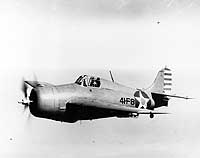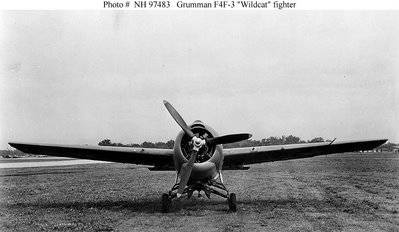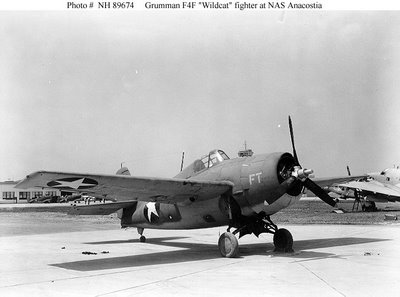







The First Team – Pacific Naval Air Combat from Pearl Harbor to Midway
and
The First Team and the Guadalcanal Campaign
John B. Lundstrom
U.S. Naval Institute Press
(Review Copy provided by review author)
I have been studying naval aviation combat since the early 1960s, and I have never come across a book half so comprehensive, from a historical basis – nor half so useful, from a modeling perspective – as this two-volume set recently reprinted by the Naval Institute Press. The title – “The First Team” – refers to US Naval Aviator fighter pilots who were in service at the start of World War II; a convenient way of focusing on naval fighter combat from December 7, 1941 to the end of the Guadalcanal campaign in early February, 1943. This was a time when the F4F Wildcat bore the brunt of the aerial warfare – a few F2A Buffalo fighters served in the Navy during this time-frame, but the only Buffalos that saw combat were serving with the Marines (who are outside the scope of this two-volume study).
This book covers literally every incident of aerial combat that included US Navy fighter aircraft from December 7 through the end of Guadalcanal. I mean EVERY incident, every American shoot-down (and every American shot down) and every American carrier attack on a Japanese island target fought during the first 14 months of the war in the Pacific: the Wake relief force, the Gilbert, Marshall and Marcus Island raids, the assault on Rabaul, and the attacks on Tulagi, Lae and Salamaua – and of course, Guadalcanal. The books also cover every carrier vs. carrier battle that was fought in the Pacific before 1944: Coral Sea, Midway, Eastern Solomons and Santa Cruz. In short, The First Team two-volume book is incredibly comprehensive. Maps and charts illustrate each battle, each significant combat incident, each movement of carriers and air groups – the detail is remarkable. Author John Lundstrom makes these battles come alive in ways that no other history I’ve read have been able to accomplish. But for all their value as pure history, these books go way beyond that.
For instance, The First Team covers combat tactics – the prime reason why the vastly-inferior F4F-4 Wildcat was able to best the incredible Japanese Zero in almost every encounter (including decisive victories at Midway and Guadalcanal). Pre-war, the US Naval air service – alone among the world’s air forces – trained its pilots to successfully use deflection shooting, permitting pilots to attack from beam positions, instead of just from directly astern. To perform a deflection-shooting attack successfully, the pilot couldn’t aim at the target; instead, he had to aim for where the plane would be when the bullets arrived.
Deflection shooting is a kind of lead-the-target targeting performed by duck hunters and skeet shooters; a process vastly complicated in aerial combat because both the attacker and the target are moving at several hundred miles per hour, generally in different planes. However, when successfully executed, deflection attacks are almost unbeatable. This kind of deflection shooting permitted American Naval fighter pilots to attack the enemy with limited risk of counter-battery fighter from defending aircraft. Deflection attacks were decisive in attacks on bomber aircraft, but this approach also gave U.S. Naval aviators a significant advantage over the more maneuverable and – at most altitudes – faster Japanese fighters.
Other tactical elements explored in great detail were the comparative tactical formations – American transition from four-aircraft divisions to two-aircraft divisions while the Japanese held onto the far more awkward and inflexible three-plane formations – as well as the evolution of the “Thatch Weave,” a mutually-supportive defensive formation the Japanese were never able to effectively counter.
The First Team also looks – in depth – at the training of Japanese and US Naval aviators. In 1941, Japanese naval aviators were, man-for-may, the best-trained pilots in the world, yet thanks to different tactical approaches, they were consistently outfought, first by well-trained US Naval Aviators and later even by grass-green Ensigns not long out of advanced training programs. Training and organization were critical – Japanese were taught to move in units of three aircraft, and to take advantage of their aircraft’s incredible maneuverability.
American Naval Aviators were trained in deflection gunnery, in pilot-wingman cooperation and in emphasizing mutually-supporting defensive tactics culminating in the unbeatable Thatch Weave – which remarkably was under development before the outbreak of the war, though “conventional wisdom” has held that Commander John “Jimmy” Thatch developed the mutual-support tactics in response to initial combat with the Japanese.
Another factor that The First Team explored which worked against the Japanese was the very different organizational structure of the two countries’ carrier air groups. In the US Navy, carrier air groups were fungible organizations – new squadrons and new pilots could be shuffled through the air groups, and these groups could be shuffled from carrier to carrier as needed. By contrast, Japanese carrier air groups trained as a unit, and were permanently assigned to a specific aircraft carrier.
When a Japanese group suffered significant combat casualties, not only were the individual squadrons no longer combat-capable, but the carrier itself was out of the battle. As a result, after the bloody draw at Coral Sea, surviving Naval aviators from the sunken Lexington were able to go back into combat onboard the Yorktown at Midway – less than a month later – effectively replacing losses the Yorktowners suffered at Coral Sea with combat-tested pilots. Even though the Yorktown had been badly damaged, it was patched together and able to field a combat-ready air group that proved decisive at Midway less than a month later.
However, as explained in The First Team’s assessment of Japan’s carrier air group organization, the Zuikaku – which, unlike the surviving Yorktown, was undamaged but which also suffered heavy pilot losses – was unable to serve at Midway because the Zuikaku’s carrier air group had been decimated, and a carrier without an air group is little more than a target. Although sufficient combat-experienced pilots from the heavily-damaged Shokaku had survived and were at least technically available, because of a long-standing organizational policy, the Japanese were unable to restore the Zuikaku’s group.
Instead, both air groups had to be restored to full combat capability only after receiving infusions of trainees, which required a long work-up period. The Yorktown’s presence at Midway was decisive; the absence of Zuikaku was at least potentially just as decisive. Had two Japanese carriers – Zuikaku and Hiryu – survived the first devastating US Naval attack, their return strike may have done more than just knock out the Yorktown.
The books even get into fascinating controversies, such as the odd decision to put six .50 caliber machine guns into the Navy’s new folding-wing F4Fs, even though they’d add a further weight penalty that would – along with the weight of the wing-fold mechanism –cripple the Wildcat’s climb, range and overall combat capabilities. The early-war fixed-wing F4F-3 carried four .50 caliber machine guns – which US Navy fighter leaders felt was sufficient to knock down unarmored Japanese bombers and fighters. However, the fixed wing took up deck and hanger space and sharply limited the number of fighters a carrier could handle. With fighter squadrons growing from 18 to 27 to 36 aircraft, the need for folding wings was essential, even though the weight penalty imposed by the folding mechanism would inevitably degrade performance.
The initial decision to go with six .50 caliber guns in a folding-wing Wildcat was made by the British Fleet Air Arm, which did not routinely face fighter-to-fighter combat – minimizing the need for high-end performance – yet rightly felt it needed the heavier firepower inherent in six .50 calibers to swiftly knock down armored and well-armed German and Italian bombers. Oddly, instead of listening to their own fighter leaders, the US Navy’s “Brass Hats” listened to the Brits, and decided – in the name of production efficiency – to standardize on the British design.
The result was the F4F-4 – a sluggish, slow-climbing short-range fighter which had six .50 caliber machine guns but fewer total rounds of ammo (and, therefore, a much shorter firing time) than the older F4F-3. This plane had a harder time climbing to a decisive altitude. It had difficulty conducting CAPs of more than a couple of hours or escorting bombers farther than 175 miles; and when it did find targets, this new Wildcat all-too-quickly ran out of ammunition. When front-line Naval Aviators complained about being asked to fight what was arguably the best carrier planes in the world with an increasingly second-string fighter plane, the Navy Brass in Washington told these front-line troops to fly their Wildcats with a 2/3rds fuel load and two unloaded guns – absurd advice to pilots who knew they needed every bullet and every gallon of gas every time they went head-to-head in combat with the best-trained naval aviators in the world, the Japanese.
These limiting factors for the new F4F clearly had an impact in the loss of the Yorktown at Midway, as well as the loss of so many torpedo planes at that same battle – and these F4F deficiencies may have also contributed to the loss of the Hornet at the Battle of Santa Cruz four months later. Nobody from the greenest Naval Aviation Ensign all the way up to Admiral Chester Nimitz had a good thing to say about the F4F-4 – but it was only after the end of the Guadalcanal campaign that the General Motors-built FM-1 reverted to a four-gun armament – too late to face down the Japanese.
Yet remarkably, the US Navy seldom fought the Japanese head-to-head without coming out on the winning end. Ultimately, the Wildcat scored a three-to-one winning margin over the Japanese – not because the Wildcat was a better fighter aircraft, though it did have some advantages, but because American Naval Aviators had better tactics, from the two-plane division to the Thatch Weave.
As noted, while it had dramatically shorter range, at least a marginally lower speed at most altitudes – and it was far less maneuverable than the Zero – the Wildcat that fought the Japanese from December 7, 1941 to February, 1943 did have some significant advantages over its adversary. The Grumman was solidly built – earning for its manufacturer the affectionate nickname “Grumman Iron Works.” The Grumman fighter was also well-armored (at least where it counted), and – early in the war – it began to receive functional self-sealing fuel tanks that would absorb a 7.7 millimeter (.30 caliber) Japanese machine-gun bullet.
While it was slow to climb, the Wildcat could dive like a bat out of hell – given enough altitude, American Naval Aviators could always break off combat with Japanese Zeros – and given an initial altitude advantage (hard to come by, but not impossible to achieve), the Wildcat could initiate combat – attack Zeros and other Japanese aircraft – with no recourse by the Japanese. They couldn’t escape a diving Wildcat; they could turn and fight, but couldn’t run away.
Further, in a head-to-head attack, the Wildcat’s rugged structure and .50 caliber armament (either four-gun or six-gun) easily outmatched their Japanese adversaries. The Japanese Zero’s 20 mm cannons were low-velocity weapons useful only at short range; the longer-ranged Japanese 7.7 mm (.30 caliber) machine guns had too little hitting power to ensure a quick victory over the Wildcat. On the other hand, the standard American .50 caliber Browning heavy machine guns were fast-firing, long-ranged and hard-hitting enough to knock down any Japanese fighter – or bomber – they could hit.
All of these factors were covered in fascinating detail in The First Team, making them a feast of information, insight and factual data for the historian – and the history buff.
Beyond that, the two “First Team” volumes also offer a great deal to modelers. Each book is heavily illustrated with contemporary photos which show evolving markings on US Navy fighters. Not a few of these photos will also offer modelers display and deck-handling diorama ideas.
In addition, Appendix 3 of The First Team and Appendix 4 of The First Team and the Guadalcanal Campaign each features side-view profiles of F4F fighters in use during the time periods covered by the books. Together, these let modelers authoritatively paint-and-mark virtually any F4F that fought off one of the USN fleet carriers during the first year of the war – including carrier-based planes that temporarily served on Guadalcanal. With the recent spate of new F4F Wildcat releases in 1/32nd scale (including the soon-to-be-here Trumpeter Wildcat), this kind of reference will prove invaluable to modelers.
Bottom line: These two books are remarkable. For those interested in carrier-based fighter combat during the dark early days of World War II in the Pacific, these are “must-reads.” The books have been released in Trade Paperback format by the US Naval Institute Press, Annapolis, Maryland – it’s also avail
No comments:
Post a Comment